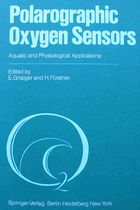Revsbech 1983 POS
| Revsbech NP (1983) In situ measurement of oxygen profiles of sediments by use of oxygen microelectrodes. In: Polarographic Oxygen Sensors. Aquatic and Physiological Applications. Gnaiger E, Forstner H (eds), Springer, Berlin, Heidelberg, New York: 265-273. |
»
Revsbech NP (1983) Springer
Abstract:
Until recently, the measurement of oxygen was restricted to the water column (Chap. III.l), since no adequate methods were available for its measurement in sediments. The use of microsensors is essential for the resolution of the steep O2 gradients often found along the sediment core. Measurements of oxygen in extracted pore water were made by several authors [2, 3, 8, 9,12], but it is difficult to obtain reliable results this way. Teal and Kanwisher [22] attempted to measure the oxygen concentration of sediments in situ by insertion of a polarographic oxygen sensor (POS), but their sensor was large and was sensitive to stirring. Although unable to record an accurate oxygen profile, their measurements indicated that the sediment was anoxic below a few mm depth. In situ polarographic analysis of sediments was made by several authors [4,11] using large platinum electrodes without membranes [15]. Because of their sensitivity to environmental conditions, e.g., interstitial water flow and the diffusion coefficient of oxygen in the sediment, it is difficult to calibrate these electrodes in terms of oxygen concentration. The readings are interpreted as oxygen availabilities, defined as the amount of oxygen reduced per unit time and per unit area of the active platinum surface. Standardized size and shape of the platinum electrode and a constant polarization voltage are necessary for reproducible results. This method is useful only in sandy sediments, and there are still difficulties in obtaining reliable results [5, 16]. Oxygen availability measurements made in coastal marine sediments generally indicate an oxygen penetration down to several cm depth in contrast to the results reported below.
Labels:
POS 1983


